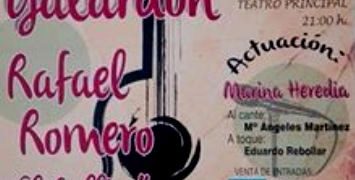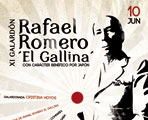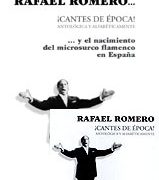|
SPECIAL REPORT: |
||
|
Just a few days ago, on October 9th, when Paco de Lucía was closing the Bienal de Flamenco de Sevilla 2010, the hundredth anniversary of the birth of legendary singer Rafael Romero who died in Madrid in 1991 was celebrated with little fanfare. As legendary as forgotten some would say, and it’s close to the truth. An elegant demeanor, even in old age, hinted at his beginnings as a dancer, as well as an innate sense of dignity that never flagged even in the poverty of his final years. Málaga guitarist Julio de los Reyes remembers how he would see the singer nearly every day at Madrid’s Bar Congosto on Aduana street: “A nice man, but rather serious and quiet”.
Oddly enough, the first anthology of flamenco singing ever recorded, came out in France on the Ducretet-Thomson label in 1954, and only several years later did it come out in Spain on the Hispavox label. Thanks to this historic collection, cantes such as alboreá, garrotín, mirabrás and caña have remained in the collective audio memory of several generations of flamenco fans in the moving voice of Rafael Romero. The singer also contributed his excellent versions of siguiriyas, tonás, martinete and debla to that unique anthology. In fact, guitarist Perico del Lunar, artistic director of the project, and who was from Jerez, saw no need to call in any other singer to leave a proper record of these difficult basic cantes. The movement today known as “Mairenism”, which attributes maestro Antonio Mairena with promoting a renewed interest in classic flamenco singing, actually began to take shape years before Mairena, along with Ricardo Molina, would write the seminal work “Mundo y Formas del Cante Flamenco”. Rafael Romero was part of those first stirrings of classicism, without rhetoric of any kind, and with no declaration beyond the weight and dimension of his personality and work.
Perico del Lunar and Rafael Romero arrived in Madrid around the nineteen-thirties. Along with singers like Pericón de Cádiz, Juan Varea, Jarrito, Manolo Vargas and Pepe de la Matrona among others, Romero spent nearly two decades singing at the mythical tablao Zambra. He also participated as singer, dancer and actor in at least nine films between 1947 and 1975. Thanks to his elegant ways, he knew how to ingratiate himself with celebrities from the world of cinema, art, literature and bull-fighting. He was a fine singer for dance, and his voice was enlisted to inspire the best flamenco dancers of the era such as Antonio Ruiz Soler, Vicente Escudero, Pastora Imperio, Rosa Durán, José Greco, Antonio Gades, Pilar López and Luisillo among others.
Romero left more than a hundred and fifty cantes recorded, in a wide range of forms and styles, including some that were on their way to being forgotten such as the soleá of José Illanda and whose recuperation is universally attributed to him. On the day of Rafael Romero’s centennial, Perico del Lunar junior, the guitarist who had accompanied him for more than thirty years, received the distinction “El Gallina” awarded annually in Andújar to remember the city’s most illustrious singer. Various prizes and honors decorate the long career of Romero himself, most notably that of the Cátedra de Flamencología y Estudios Folklóricos Andaluces de Jerez de al Frontera in 1973. In his native Andújar there exists a street with his name, and a commemorative bust.
Distinguished flamenco investigator Pierre Lefranc met our man in the nineteen-fifties in Paris where the latter was well-known thanks to his recordings made in France. In a small venue called El Catalán, “before a small number of spectators (perhaps 40 people at most) who listened in rapt, serious and absolutely enthralled attention that even bordered on devotion”, Lefranc experienced his first cante gathering, something that would hook him irrevocably and for life on the genre. Professor Lefranc ceded Deflamenco the following biographical text extracted from his presentation of “Grabaciones en París” of 2004. RAFAEL ROMERO: Biographical notes Rafael Romero was born in 1910 into a gypsy family in Andújar, Jaén, where there was very little cante, although relatives did sing and dance. His father was a livestock trader. Rafael first became a dancer, and moved to Madrid during the Spanish Civil War. Difficult times followed during which he sang and danced a little song called “La Gallina Papanata”. That earned him the affectionate nickname “Gallina” given him by a marquis. The name stuck permanently, and decades later Romero did not appreciate it. His artistic name was never any other than Rafael Romero.
In Madrid, Perico del Lunar tells us he saw in Rafael a singer with a good flamenco voice and the ability to stir emotions, and he taught him many cantes including those without guitar that Chacón had used to sing, and the great cantes of the interior such as caña, polo and serrana. In a certain sense, Rafael became Perico’s voice, yet always preserving his own personality; the emotion he pulled up was his, the unmistakable mark he left on the caña is unforgettable and he was studious and inquisitive enough to recuperate and save some cantes that were on their way to extinction. The positive side of all that can be seen in his career and recordings, but there was another relatively fragile aspect. He was known in France, in Japan and in Zambra, and he was a star as a result of the Antología, but that was based on cante learned as an adult and it lacked Andalusian roots so to speak. Furthermore, the eighteen years he spent working at Zambra (which closed in 1975) were a time of such professional stability, and so unprecedented, that he ran the danger of becoming complacent – as he himself realized. When Fernando Quiñones asked him why no new cantes were created any more, Rafael answered lucidly with the following: “The people who created the cantes pulled them out of their hunger and suffering. How can I possibly do that, with my pockets always full of money, smoking these expensive cigarettes, my agenda and my fancy clothes and the life there is today?” His final years were difficult. In 1973 the Cátedra de Flamencología de Jerez awarded him its Premio Nacional de Cante. Zambra closed two years later leaving him floundering in a new Madrid with a name linked to the past. He continued to be an international star, having gone on to record again in Paris in 1971 and Japan in 1988, but his appearances within Spain were few, and mostly limited to his home province of Jaén. He died in poverty in 1991 in Madrid. Nevertheless, he is and will continue to be one of the greats of the history of cante, because of his love for the art, his dedication and constancy, the communicative power of his cante and the generosity with which he took young people like Menese, Morente, Miguel Vargas, Carmen Linares and others under his wing and gave them advice; they all considered him a maestro.
|
Descubre más desde Revista DeFlamenco.com
Suscríbete y recibe las últimas entradas en tu correo electrónico.
































